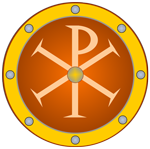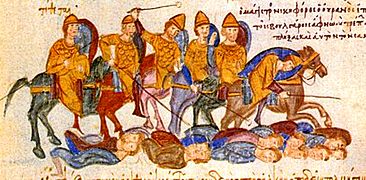
Battle of Kleidion(Battle of Balathista or Belasitsa or Clidium) |
year: 101429 July 1014 |
| A decisive Byzantine victory which led to the surrender of the Bulgarians | ★ ★ ★ ★ ★ |
|
enemy: Bulgarians
|
location: Between the mountains of Belasitsa (Belles) and Ograzhden near the modern Bulgarian village of Klyuch
|
accuracy:
●●●●●
|
|
battle type: Mountain Battle |
war: Conquest of Bulgaria |
modern country:
Bulgaria |
| ▼ The Byzantines(emperor: Basil II Bulgaroktonos) | ▼ The Enemies | |
| Commander: | Emperor Basil II | Tsar Samouil |
| Forces: | Unknown | 20,000 |
| Losses: | Light | 15,000 blinded, many killed |
| Background story: |
| After the defeat of the Bulgarians in Spercheios, in 997, a new phase of the Byzantine-Bulgarian war began in 1000, when Emperor Basil II, having secured his throne, launched a series of campaigns. He secured Moesia, and in 1003, his forces took Vidin. The next year, Basil inflicted a heavy defeat on Tsar Samouil in the Battle of Skopje. By 1005, Basil had regained control of Thessaly and parts of southern Macedonia. Over the next few years, a regular pattern emerged: the Byzantines would campaign in Bulgaria, laying siege to forts and pillaging the countryside, while the numerically inferior Bulgarians, unable to offer direct opposition, launched diversionary raids in Macedonia and Greece. Samouil could not stop Basil in the open field or engage the Emperor in a decisive battle, and suffered many defeats and began to lose his strength and his authority in his own country. The culmination of the war came in 1014, when Samouil, resolved to stop the Byzantine army before it could enter the Bulgarian heartland. To face the expected Byzantine offensive, Samouil gathered a large army, with as many as 45,000 soldiers. The Bulgarians built ditches along the frontier and fortified many of the valleys and passes with walls and towers. |
The Battle: |
 The battle of Kleidion Basil II, understanding that it would not be easy to overcome this obstacle, ordered his general Nikephoros Xiphias to maneuver his troops around the high Belasitsa mountain and surround the Bulgarians, while he continued the assaults on the wall. Xiphias led his troops along a steep path that led him into the Bulgarians' rear and on July 29, he attacked. The trapped Bulgarian soldiers abandoned their fortification to face this attack and Basil, on the other side, was able to break through the wall. In the confusion of the rout, thousands of Bulgarian troops were killed and the rest desperately attempted to flee westwards. Samouil and his son Gabriel Radomir immediately left their headquarters and tried to bring reinforcements in the valley, but in desperate fighting near the village of Mokrievo they were overwhelmed by the quickly advancing enemy. Many Bulgarian soldiers were killed at Mokrievo and many more were captured. Emperor Samouil himself barely escaped. A claimed 15,000 Bulgarian prisoners were blinded and sent home to Tsar Samuel, who reputedly died of the shock, 2 months later. |
Noteworthy: |
| After this battle, Basil II gained the nickname "Bulgaroktonos" or "Bulgar-Slayer". A hero for the Greeks, a monster for the Bulgarians. |
Aftermath: |
| It was the critical battle although the war did not end immediately. The Bulgarians fought hopelessly until 1018, but they were forced to subdue. The Byzantine borders were restored to the Danube after 400 years (with the wxception of the Tsimiskes’ period). |
|
|
